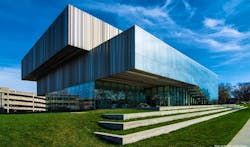Metal Clad Buildings: A Sustainable Game-Changer in Modern Construction
As builders and developers increasingly prioritize environmental responsibility, designing metal roof and wall systems has emerged as a standout solution for sustainable construction. These structures aren't just practical - they're helping projects achieve those coveted LEED certifications while delivering energy-saving benefits.
Metal cladding is a top material for new energy-efficient construction, it is also an ideal material for retrofitting and modernizing existing structures. The saying is true: the greenest building is the one that’s already built. Metal roofing and wall cladding can provide air and moisture barriers, enclosing old, wasteful buildings into highly efficient and modern-looking icons.
Why Metal Makes Sense
Think about what we want from sustainable buildings: lower energy bills, healthier indoor spaces, and minimal environmental impact. Buildings clad in metal check all these boxes. They:
- Cut energy costs significantly
- Create comfortable, clean indoor environments
- Meet or exceed today's tough energy codes
- Leave a smaller environmental footprint
- Can be recycled over and over again
The Endless Life Cycle
Remember playing with building blocks as a kid? The "Cradle to Cradle" concept is similar - instead of throwing materials away, we keep reusing them. Metal is perfect for this approach because it never loses quality no matter how many times it's recycled. Unlike materials that eventually end up in landfills, metal can keep serving new purposes indefinitely and promote a truly circular economy.
Recycling That Actually Works
We've all become skeptical of recycling claims, but metal is the real deal. Steel and aluminum can be recycled endlessly while maintaining important properties such as strength and ductility, and about 70% of metal panels already come from recycled materials. Better yet, there's money in metal recycling, so it happens consistently, whether it's leftover materials from construction or metal panels from demolished buildings. Just because construction materials can be recycled, doesn’t mean they are in practice. According to the BBC, it can be complicated to recycle concrete because concrete can contain lots of contaminants. While about 30% of concrete contains recycled content, it is typically downcycled to rubble for use in other applications because its performance is often reduced. Wood is similar, while it can be downcycled and reused, nothing approaches the high rates of recycled metal.
Smarter Construction, Less Waste
Traditional building methods can be incredibly wasteful - wood framing alone can result in 20% of materials ending up in dumpsters. Metal-clad buildings take a different approach. Components arrive pre-made and ready to assemble, which means:
- Fewer workers needed on-site
- Faster completion times
- Fewer mistakes and wasted materials
- Cleaner job sites
Built-In Energy Savings
Metal buildings are natural energy-savers thanks to top-notch insulation systems, better sealing against air and moisture leaks, heat-reflecting coatings for cool roofs and walls, and are ideal for solar panel installation.
These features not only slash energy bills but also make buildings more comfortable year-round. Plus, metal roofs are perfect for solar installations because they will last longer than the solar panels themselves. Preventing re-roofing and the need to remove panels and reinstall them. If you are considering solar now or in the future, metal roofing prevents issues down the road.
Creating Healthier Indoor Spaces
Green building isn't just about saving the planet - it's about creating better spaces for people. Since metal components are typically manufactured off-site, there's less risk of harmful chemicals being released during construction. The design flexibility also makes it easy to add features like natural lighting and good ventilation that help people feel their best indoors.
The LEED Advantage
For projects aiming for LEED certification, buildings with metal panel systems offer a straightforward path to success across key categories:
- Site sustainability
- Energy efficiency
- Material use
- Indoor environment quality
These advantages can help buildings achieve any LEED level, from basic certification to prestigious Platinum status.
As we face growing pressure to build more sustainably, metal clad buildings offer practical solutions that work for both the environment and the bottom line. They're durable, adaptable, and genuinely sustainable, proving that going green doesn't mean compromising on performance or profitability.
About the Author

Partner Content
Partner Content is submitted by our advertisers and does not represent the views of BUILDINGS or its publisher, Endeavor Business Media. Content may be edited for clarity and style.

